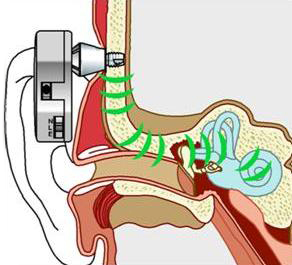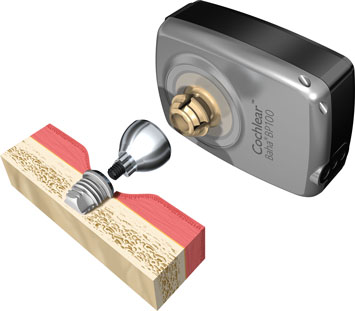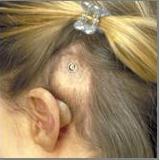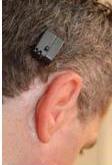Hearing Aids
Bone Anchored Hearing Aids
The majority of hearing losses in adults are termed as sensory neural. This means that the hearing loss has taken place as a result of an under functioning of either the cochlea (often referred to as the inner ear) or the nerve beyond the cochlea. For this type of hearing loss if required a conventional hearing aid is usually prescribed.
The other type of hearing loss in adults is termed as conductive. This type of hearing loss occurs as a result of problems in either the middle ear space (this area contains the ossicles and is found behind the ear drum but in front of the cochlea) or the outer ear (this area contains the ear canal and ear drum, both of which are visible to your audiologist). With a conductive hearing loss you will always find that the cochlea function or level of hearing is better than the overall function or overall level of hearing. For this type of hearing loss, while a conventional hearing aid may be used, there may also be a number of reasons why such an aid would be impractical. These may include chronically infected and discharging ears or canal atresia (closure or absence of the ear canal). For these types of pathologies it would be useful if we were able bypass and or avoid these difficulties stimulating the inner ear (cochlea) directly rather than through the conventional route of outer, middle and then inner ear. In stimulating the inner ear directly we also gain the advantage that the inner ear function is better than the overall function.
How do we bypass difficulties in the outer and middle ear?
We are able to bypass problems in the outer and middle ear by the use of a bone conduction aid. In the short term this may be carried out by using a bone conduction aid attached to a head band. This rests on the bone immediately behind the ear and the vibrations produced by the hearing aid pass on through the bone and stimulate the cochlea or inner ear directly. In the longer term it may be both beneficial in terms of comfort and efficiency of the sound produced by the aid to have the aid attached to an implant located immediately behind the ear. This arrangement is known as a bone anchored hearing aid.
As the diagram illustrates the bone acts as a pathway for the sound to travel from the bone anchored hearing aid, through the bone and directly to the cochlea.

The implant is made of titanium and surgery would be carried out by an ENT specialist. Before this can take place, an assessment procedure both by the Audiologists from Chime and later by an ENT specialist needs to take place to determine suitability.
Would I be suitable for this Procedure?
You may be suitable for this procedure if:
- You have a conductive or mixed (conductive and sensory neural) hearing loss.
- You have an incomplete or missing ear canal.
- You have poor or nonexistent hearing on one side.
What Should I do if I think I am Suitable for a Bone Anchored Hearing Aid?
Referral for assessment for a Bone Anchored Hearing aid usually comes via ENT or Chime Audiology, if you are already a hearing aid user. However your GP may also refer you for assessment either directly to Chime or via ENT. Please talk to your GP, ENT consultant or Chime Audiologist if you think you may be suitable.
What will Chime Audiology do during your Assessment?
A bone anchored hearing aid assessment with a Chime Audiologist will involve an initial examination of both of your ears, followed by an updated hearing test. A further test known as speech audiometry will be carried out to test your speech discrimination (your ability to successfully interpret common speech sounds). A subjective test using a bone anchored hearing aid and a headband will be carried out to give you an idea of what listening using a bone anchored hearing aid will be like. These tests will help us determine not only your suitability for a bone anchored hearing aid, but also the model of bone anchored hearing aid that you may require.
During this appointment your Chime Audiologist will provide you with information as to the procedure involved and give an opportunity to ask questions.
Once the assessment is over, a letter will be sent to both your GP and ENT consultant detailing your audiological suitability for the procedure. Your Chime Audiologist will have discussed this with you at the end of your assessment appointment.
Once the ENT consultant has received the audiological report, they will usually send you an appointment to be seen at an ENT clinic. The final decision as to a candidate's suitability will be made by the ENT consultant.
An Audiological Assessment for a bone anchored hearing aid usually lasts 90 minutes.
What happens if I am approved for a Bone Anchored Hearing Aid?
Your ENT consultant will arrange a date for surgery and the implantation of the abutment. The details of what will happen when you visit for surgery are detailed in the Royal Devon and Exeter NHS Foundation Trust information booklet “Bone Anchored Hearing Aid (BAHA) Surgery”.

An outpatient appointment will be given to you so that you may be seen in the ENT clinic 10 to 14 days after surgery to have any stitches removed and check the healing process. The site of the implant will then be cleaned and redressed by ward staff. This may need to be done weekly until you are able to have this done correctly at home with the help of a member of your family.
What happens following surgery?
It may take up to three months for the implant and the bone to bond completely together. Once this has happened your ENT consultant will inform Chime Audiology so that your fitting appointment may be arranged.

What happens at my fitting appointment?
When the time comes to have your bone anchored hearing aid fitted, Chime Audiology will send you an appointment. Expect the appointment to last approximately 90 minutes.
During the appointment the bone anchored hearing aid will be programmed to your hearing loss. You will be shown how to operate the bone anchored aid, including changing the volume and any programmes that are added. You will be instructed on how to fit your new aid to your abutment. This will all be backed up with written instructions.
Whether or not you are new to the department we will advise you how to maintain and repair your hearing aid, obtain batteries or other parts relevant to your hearing aid.

Twelve weeks after your fitting appointment you will have a review appointment to ensure that your fitting has been successful and make any changes to your bone anchored hearing aid that may be appropriate.
The bone anchored hearing aid is available in a variety of colours and you will be asked to make your choice before the fitting appointment.
All photographs in this section are courtesy of Cochlear BAHA.
